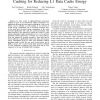Free Online Productivity Tools
i2Speak
i2Symbol
i2OCR
iTex2Img
iWeb2Print
iWeb2Shot
i2Type
iPdf2Split
iPdf2Merge
i2Bopomofo
i2Arabic
i2Style
i2Image
i2PDF
iLatex2Rtf
Sci2ools
ICCD
2006
IEEE
2006
IEEE
Fast Speculative Address Generation and Way Caching for Reducing L1 Data Cache Energy
— L1 data caches in high-performance processors continue to grow in set associativity. Higher associativity can significantly increase the cache energy consumption. Cache access latency can be affected as well, leading to an increase in overall energy consumption due to increased execution time. At the same time, the static energy consumption of the cache increases significantly with each new process generation. This paper proposes a new approach to reduce the overall L1 cache energy consumption using a combination of way caching and fast, speculative address generation. A 16-entry way cache storing a 3–bit way number for recently accessed L1 data cache lines is shown sufficient to significantly reduce both static and dynamic energy consumption of the L1 cache. Fast speculative address generation helps to hide the way cache access latency and is highly accurate. The L1 cache energy-delay product is reduced by 10% compared to using the way cache alone and by 37% compared to the ...
| Added | 16 Mar 2010 |
| Updated | 16 Mar 2010 |
| Type | Conference |
| Year | 2006 |
| Where | ICCD |
| Authors | Dan Nicolaescu, Babak Salamat, Alexander V. Veidenbaum |
Comments (0)

